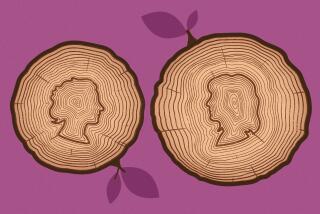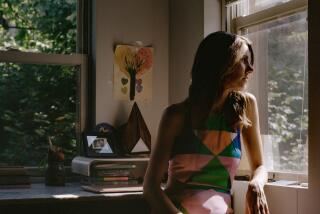Tale of two Pasadena girls: Aria Beth Sloss’ ‘Autobiography of Us’
Don’t be confused by the title “Autobiography of Us”: This story set in mid-century Pasadena is actually a novel. It’s the debut from Aria Beth Sloss, who gave birth to a baby the same month as her book was published. (Our interview took place via email on her due date.)
Inspired by Sloss’ own mother’s Southern California upbringing, “Autobiography of Us” introduces the reader to two 14-year-old girls living in the patrician neighborhood of Pasadena during the late ‘50s. In the book, the mismatched girls, Rebecca and Alex – one worldly and independent, the other quiet and bookish – become lifelong friends. Although they come of age during the 1960s, they struggle to navigate a world that limits their professional and personal aspirations.
What inspired you to write this first novel?
I never meant to write a novel, which is probably what allowed me to start one. When I sat down and wrote the first few pages of what would ultimately become “Autobiography of Us,” I thought I was writing a short story. Some sixty-odd pages later, I brought what I had to a novella workshop at Iowa, where Ethan Canin kindly pointed out that I was writing a novel. I remember walking out of his classroom that day feeling like I’d been hit by a train. But the larger point is that the subject matter -- these women who came of age in the early 1960’s, caught between the Donna Reed housewife prototype of the 1950’s and the Second Wave feminism that exploded at the end of the decade -- demanded more space. And so the inspiration for the book became its greatest challenge: how do you tell the story of an entire generation in a few hundred pages?
Why did you choose to set your novel in Pasadena?
My mother came of age in Pasadena during the same era as the book’s main characters. I grew up visiting my maternal grandparents every year, in the same house in which my mother had grown up. So it was a place alive with my mother’s memories, a place I could look around and see all the signs and markers of the girl she’d once been. But the Pasadena I experienced as a child also remained, even in the 1980’s, a place that felt oddly closed off. It wasn’t quite of its time. The only non-white faces on the streets belonged to housemaids and lawn workers, and at the country club, where we ate lunch, everyone greeted my grandmother by name. It occurred to me when I started “Autobiography” that this was a community in which the reverberations of all the social changes the 1960’s ushered in would have been muffled, to put it mildly. Fiction demands a kind of compression that makes situations in which tensions are already distorted or exaggerated a godsend: the fact that I had Pasadena and this particular time period rattling around in my mind all those years was sheer luck.
And why did you choose to set the novel in the 1960s?
At a certain age I became aware that my mother was older than my friends’ mothers (I’m the youngest of three by six and nine years). Because of a margin of no more than a few years, everything about her experience as a young woman differed from theirs. She didn’t protest Vietnam; she didn’t go to Woodstock; she didn’t match the vision of American youth during the 1960’s I’d pieced together from my friends’ parents’ photographs and stories. As I got older, I became fascinated by the idea that there was an entire pocket of women history had passed over. My mother’s generation was born late enough to glimpse opportunities for women beyond marriage and motherhood, but they were also, cruelly, born too early to benefit from second-wave feminism and the changes it began ushering in by the late 1960’s and early 70’s. By the time leaders like Gloria Steinem and Germaine Greer appeared on the horizon (not to mention NOW and the Equal Rights Amendment), it was too late: my mother and her friends were married with children, settled into lives that turned out to look very much like their mothers’ lives. So much changed over the course of that one little decade. All it took was graduating college a few years earlier, and the world into which you entered was a very different one.
What type of research did you have to do in order to paint a picture of that city during that time period?
Very little, to be honest. Luckily, Henry Holt (my publisher) has a SWAT team of fact-checkers and proofreaders who went through the pages toward the end and checked every street name and sunset time. Turns out I failed the flora and fauna of Southern California miserably -- why had I always remembered the sound of cicadas at night? -- but those were easily fixed errors. It’s always important to get the facts straight: as a fiction writer, you’re building a dream, and that dream needs to progress without any logistical snags or you risk the reader getting nudged awake.....
Why did you want the story to center on the relationship of two best friends? Why not sisters or a mother-daughter relationship?
I actually think of the story as centering around all three of those relationships. So maybe the answer is that the kind of female friendship I wrote about seems to me to involve elements of each. Part of this is the age Rebecca and Alex happen to be when they meet -- there’s a fluidity to teenage girls and their sense of identity that makes those intense friendships so many women have during those years possible. Over time, that intimacy is generally (and quite naturally) replaced by romantic relationships. It occurred to me as I worked on “Autobiography” that it would have to be both an extraordinary friendship as well as an extraordinary set of circumstances to break that natural progression. There was so much about these two women and their lives that seemed to me to create the perfect storm of disappointment and desire, exactly the kind that might allow a relationship like theirs to continue to carry enormous weight. In the end, I wasn’t surprised to find myself writing about a friendship that looked a lot more like love.
The novel takes place during a time in which women were limited when it came to their professional or personal pursuits. Now, more than 50 years later, with all the progress women have made, have you experienced moments where you have felt held back professionally or personally as a result of your gender?
I hate sounding like some doomsday oracle, but I can’t help but take issue with a phrase like “all the progress women have made.” Yes, women now work outside the home in sizable numbers, and yes, we are now able to have giant sweeping discussions about “having it all,” but I’m afraid I don’t see these past few decades as having made anywhere near the impact they might have. In Betty Friedan’s ”The Feminine Mystique,” published fifty years ago this month, she takes American society to task for treating women like second-class citizens: I would argue that we still are. I was just reading a piece in the New York Times this morning that points to the United States as one of only eight countries without paid maternity leave -- eight countries! How much has changed if women are still being punished for bearing children? It’s precisely because I felt so frustrated at the lack of progress in today’s society and its treatment of women that I started writing this book. When I see it filed under “historical fiction” on Amazon or elsewhere, I have to laugh. I wish these issues were history. The sad truth is that they continue to be the most current of events.
We follow Rebecca and Alex’s friendship over years — we experience their choices and their crises. But it’s clear that as an author, you never judge your characters.
The truth is that I found it incredibly difficult to step outside this story. And a certain amount of distance is crucial. As a writer, at some point along the way you need to play God; you need to look down at the world you’ve created and say “this is good,” “this is not good,” “I think we need to add a few zebras,” etc. But I was completely and unhelpfully immersed in the book for the vast majority of its writing.
Allan Garganus, one of the world’s loveliest human beings, once wrote me a note suggesting I try changing the entire document into a different font: I think he saw my expression at the dinner table one night at the residency we both attended one winter and recognized the look of utter despair. It turned out to be a great suggestion, one I think illustrates how common this problem must be. When you work every day inside the same characters’ minds, molding and pressing and tearing apart the same scenes and lines, getting out to take a clean look at what you’re doing can start to feel impossible. So I think maybe compassion, in this case, is something closer to commiseration: you’re stuck in there together, you and all the characters you’re working with. Judging them feels like judging someone you’re drowning next to -- what would be the point? Don’t you both just want to be saved?
ALSO:
Ninth annual Tournament of Books begins today
Eloise Klein Healy paints Los Angeles in her poems
Rebecca Miller keeps her eye on the fly in ‘Jacob’s Folly’
More to Read
Sign up for our Book Club newsletter
Get the latest news, events and more from the Los Angeles Times Book Club, and help us get L.A. reading and talking.
You may occasionally receive promotional content from the Los Angeles Times.







